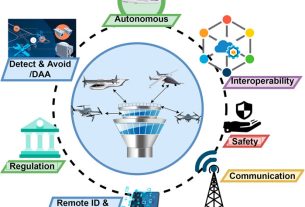COLOGNE, November 19, 2025 – From emergency rescues and medical transfers to disaster relief and law enforcement, helicopters quietly serve communities across Europe every day. This week Cologne hosted the EUROPEAN ROTORS show this week. During the event, the European Union Aviation Safety Agency (EASA), Airbus Helicopters and the air-rescue operators ADAC Luftrettung and DRF Luftrettung brought helicopter missions to life through a live hoist demonstration on the River Rhine, showing how rotorcraft save lives when every second counts.
The coordinated rescue scenario, performed from a tourist vessel operated by the KoelnTourist Ship Company, demonstrated the lowering of rescuers and the subsequent pick-up of the rescuers and their patients. Against the backdrop of Cologne’s skyline, the two operators demonstrated precision flying, teamwork and trust — the skills that make real-world missions possible in floods, road-traffic collisions, and medical emergencies.
“Helicopters are more than machines — they are lifelines,” said Stefano Fico, Head of the Rotorcraft and General Aviation Department at EASA. “Whether during the floods in the Ahr Valley in Germany, a mountain rescue in the Alps, or an urgent organ transport at night, rotorcraft connect people in crisis to help. Our role at EASA is to ensure these operations remain safe, sustainable, and available whenever and wherever they are needed.”
For DRF Luftrettung and ADAC Luftrettung, the demonstration was an opportunity to show the professionalism, training and reliability that define Europe’s helicopter emergency medical services (HEMS). Both operators perform thousands of missions each year across Germany and beyond, supported by European-wide safety standards, modern aircraft and highly skilled crews.
“ADAC Luftrettung is regarded as a pioneer in rescue-hoist operations and has been carrying out these specialized missions since 1995 — currently from six bases throughout Germany. Our rescue-hoist helicopters are also deployed in disaster-relief operations,” says Frédéric Bruder, CEO of ADAC Luftrettung. “To reach patients even faster, we became the first organization in Germany to introduce immediate rescue-hoist readiness. This enables our crews to respond directly to hoist missions after being alerted, without reconfiguring the cabin or making an intermediate landing — saving up to ten minutes in an emergency. We first demonstrated the effectiveness of this concept during the flood disaster in the Ahr Valley. Given the growing importance of rescue-hoist operations, our latest virtual-reality simulator will soon be available to international crews at the new ADAC Air Rescue Campus near Munich.”
Dr. Krystian Pracz, CEO of DRF Luftrettung, commented: During the hoist demonstration in Cologne we were able to showcase our professionalism in hoist rescue. For over 25 years, we have been carrying out rescue operations in difficult terrain using hoists, consistently relying on state-of-the-art technology and the highest training and safety standards. Helicopters equipped with rescue hoists are in use at five of our 31 HEMS bases nationwide – and have already saved numerous lives. With initiatives such as the international HHO symposium and the development of the world’s most advanced mobile hoist simulator, hoistAR®, we are actively driving forward the future of hoist rescue. Our goal is clear: through excellent training, continuous development and strong partnerships – for example with the mountain rescue service – we ensure the best possible care for our patients”.
European Rotors 2026
Beyond the impressive display of skill, EUROPEAN ROTORS 2025, emphasised a broader message: rotorcraft are an essential part of Europe’s safety, mobility and resilience ecosystem. They provide:
- Rapid medical evacuation and emergency response in remote or urban areas;
- Airborne support for firefighting, police and civil-protection missions;
- Critical logistics during natural disasters and infrastructure disruptions; and
- Employment for tens of thousands of professionals — pilots, engineers, technicians and medical specialists.
“As Europe looks to the future, we must continue to promote the value of rotorcraft and the people who make them fly,” added Fredrik Kämpfe, Chairman of the European Helicopter Association. “This sector offers extraordinary opportunities for young people — from next-generation aircraft design and maintenance to digital systems, safety oversight and rescue operations. A strong rotorcraft community means safer, stronger and more connected societies.”
EUROPEAN ROTORS 2025, co-organised by EASA and the European Helicopter Association (EHA), produced by European Rotors GmBH with the support of the technical expertise of Vertical Aviation International (VAI). The event brought together industry leaders, operators, regulators and innovators to discuss the future of rotorcraft safety, sustainability and workforce development.



